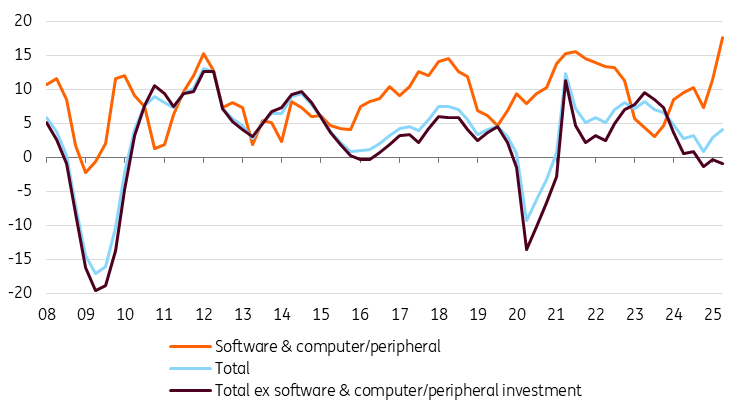Janux stock plunges after hours following mCRPC trial data
Tech-fuelled growth attracts the headlines, but headwinds from the government shutdown are becoming more apparent as consumer confidence continues to slide. The absence of official data is clouding the situation, but business surveys suggest the Federal Reserve will likely cut rates further despite recent hawkish messaging
Shutdown Creates More Headwinds for Growth
We’ve written extensively about the bifurcation of US consumers. The top 20% of earners are in excellent financial shape and continue to spend aggressively, while the bottom 60% are struggling due to inflation, job worries, and limited exposure to rising asset prices. We’re also seeing more bifurcation in the broader economy between tech-related sectors, where the AI boom is driving spending and profits, and non-tech, where investment is much weaker.
The chart below shows the divergence in business capex spending. We observe similar trends in construction activity. However, hiring remains weak for both tech and non-tech sectors.
The government shutdown is contributing to these trends. It has lasted more than a month, and political intransigence suggests we should brace for it lasting, potentially, several more weeks. This is putting financial pressure on federal workers who aren’t receiving pay cheques (funding was found to pay members of the military).
The Department of Agriculture has warned that 42 million Americans might not receive their full allocation of SNAP benefits (food stamps) this month. Federal funding has been cut for several infrastructure projects. The granting of federal permits and certifications for business has been suspended, and access to federal loans and subsidies has been interrupted.
This is weighing on near-term economic activity. Typically, the effects reverse after a shutdown ends. However, the longer it lasts, the greater the chance it has of a more permanent slowing influence on activity. Moreover, federal statistics agencies are not collecting and publishing data.
This is creating greater uncertainty over the state of the economy. It’s also making life harder for the Federal Reserve as it seeks to optimise monetary policy for its dual goals of price stability and maximising employment.
Business Capex Led by Tech Investments (YoY%)

Source: Macrobond, ING
Fed Suggests Further Rate Cuts Aren’t Guaranteed
The Fed resumed interest rate cuts in September, followed by a further 25bp cut at the 29 October Federal Open Market Committee (FOMC) meeting. However, Fed Chair Jerome Powell suggested that further rate cuts are not guaranteed – “far from it” in fact.
Growth has proved to be resilient thanks to tech-related investment, inflation is above target, unemployment is low, and equity markets are at all-time highs. So, it’s understandable that several Fed officials think the market has got ahead of itself in believing the Fed is on a preset course of cutting the policy rate down to 3%.
There’s a very real chance that we will receive little to no official government data ahead of the 10 December FOMC meeting. We will have third-party business surveys and job numbers along with the Fed’s Beige Book, so policymakers won’t be completely blind. But the hurdle for action has been raised, with several officials indicating they’re not convinced of the need for further easing. The primary issue is the scarcity of inflation metrics.
Job Slowdown Will Dampen Inflation
Our view on inflation is that while the impact of tariffs has been slow to materialise, the risk of one-off price hikes remains real. However, the slow pass-through gives more time for the disinflationary impulses from lower energy costs, slower housing rents, and weaker wage growth to mitigate and limit the rise in inflation.
On jobs, there’s broad evidence of a cooling in hiring, and households remain nervous about job security. So far, layoffs have not been significant, despite prominent employers, including Amazon (NASDAQ:AMZN) and United Parcel Service (NYSE:UPS), announcing significant employee reduction programmes.
At the same time, the Institute of Supply Management (ISM) business surveys continue to point to a slowing growth story. Credit and debit card spending numbers also suggest a moderation is underway. As such, we continue to expect a December rate cut, followed by two further rate cuts in 2026.
President Trump’s trade policy continues to create uncertainty. There’s also the prospect that it could be overturned. The Supreme Court may uphold the decision of lower courts that found Trump’s use of the International Emergency Economic Powers Act (IEEPA) as a basis for imposing tariffs to be unlawful. Oral arguments were heard 5 November.
If the court rules against the tariffs, the government will be required to repay them, with Treasury Secretary Scott Bessent admitting, “We would have to give a refund on about half the tariffs.” The upshot, though, would be a dampening of inflation pressures, but also heightened concerns over the sustainability of the US fiscal position. They were expected to contribute $2.5tr of tax revenue over the coming decade.
Disclaimer: This publication has been prepared by ING solely for information purposes irrespective of a particular user’s means, financial situation or investment objectives. The information does not constitute investment recommendation, and nor is it investment, legal or tax advice or an offer or solicitation to purchase or sell any financial instrument. Read more
